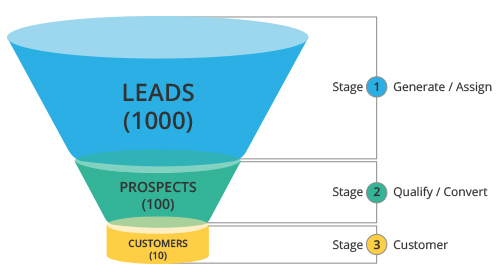
What is lead and what is a prospect?
Table of Contents
this question has eaten many peoples head. If you have been blindly using these terms until now with not much of difference, thats okay! We all get confused with these 2 terms but let’s see what they exactly mean. Lets take below example You use Lead generation and someone fills the form on your landing page – that is a lead.
There are different sources which might direct traffic to your website such as social media, email marketing, blog posts, cold calling, direct mail, etc. No matter what the source the actions such as, filling the form online or responding to CTA on your landing page shows that the person is interested in you. Any person who gives their contact information and is interested in you can be called a lead.

Source: https://aeroleads.com/blog/
Just as the name indicates a prospect is a person who can develop an interest in your product if they fit into your buyers persona. Lets put it this way, If you are a business who offers female beauty products to the customers. You use social media network like Facebook, Linkedin very well for your e-commerce and you also have a number of existing customers joined to your Facebook business page.
While doing marketing campaigns on Facebook, you will use a very useful tool such as lookalike audience, where you can attract a similar group of people as your customers to your product. Lookalike audiences are people who could be interested in your products if they come to know about your products. You can use demand generation strategies to target these people and create your brand awareness. As you sell female products, basically any female who you think could buy your product can be called your prospect.
People usually decide their target audience based on different criteria such as demographic info, their career info, etc. It is advised that we create buyers persona and tailor our marketing services to their needs. As said by Ann Handley, a content marketer and the author of the book everybody writes, you should write with one person in mind.
This is the person who would define your ideal buyers attributes. Once you have set this in mind, it becomes easy to target people that fit into your buyers persona. There is a lot of difference though in a lead and a prospect? How so? Lets see below lead vs prospect difference. What can you tell from the following statistics taken from Jumplead
- 61% of B2B marketers are able to generate high-quality leads with great difficulty. B2B Technology Marketing Community
- 63% of consumers who ask for your company info today will not buy at least until 3 months. Marketing Donut
Read More: 7 Lead Management Strategy Best Practices
Above statistics give us an idea that not many leads that you get fit into your buyers persona. Though giving contact information, signing up for the newsletter is a major indication of someone’s interest in your brand, it isn’t true in more than 50% of cases. Did you get it? Leads are just someone who signed up for the newsletter but doesn’t mean they are likely to buy. That is why many apply BANTs criteria to qualify the leads further. The leads when qualified (Marketing qualified or Sales qualified) can be called as prospects as they are your ideal buyers who have shown continued interest which cannot be mistaken.
As defined prospect is a potential customer as they come under your target market, want to buy and have the budget and authority too. Prospects are at first leads, or in different words, another opportunity to turn someone into a potential customer.
If you are selling software solutions to small businesses, the small business managers are your prospects but if they are not in charge of making a decision for this then they are not your prospects. However, if you haven’t qualified any contact as a prospect, it is to be called lead. This is how a general sales process carries on.

Source: https://www.zoho.com/crm/help/img/sales-funnel.jpg
1. Prospecting:
Here you gather as many leads as possible.
2. Qualifying leads into prospects:
This doesn’t have to a lengthy process but only a few questions such as below would help you identify if they are prospects.
- When do you intend to buy?
- What is your budget? What are your plans for the year?
- Who are decision makers?
3. Selling Phase:
Once the prospects are qualified because of further interest they show, the selling cycle begins. The selling phase can be short or long depending on your products. I hope above all points helped you understand the difference between a lead and a prospect. If it gets any hard with the terms with similar meaning like, you can feel free to ask us through email. We are ready to solve your questions like What is the difference between Demand Generation and lead generation? Is Data cleaning and data scrubbing the same?
Read more about it in our blog posts.
Thank you 🙂

Vikas Bhatt is the Co-Founder of ONLY B2B, a premium B2B lead generation company that specializes in helping businesses achieve their growth objectives through targeted marketing & sales campaigns. With 10+ years of experience in the industry, Vikas has a deep understanding of the challenges faced by businesses today and has developed a unique approach to lead generation that has helped clients across a range of industries around the globe. As a thought leader in the B2B marketing community, ONLY B2B specializes in demand generation, content syndication, database services and more.


